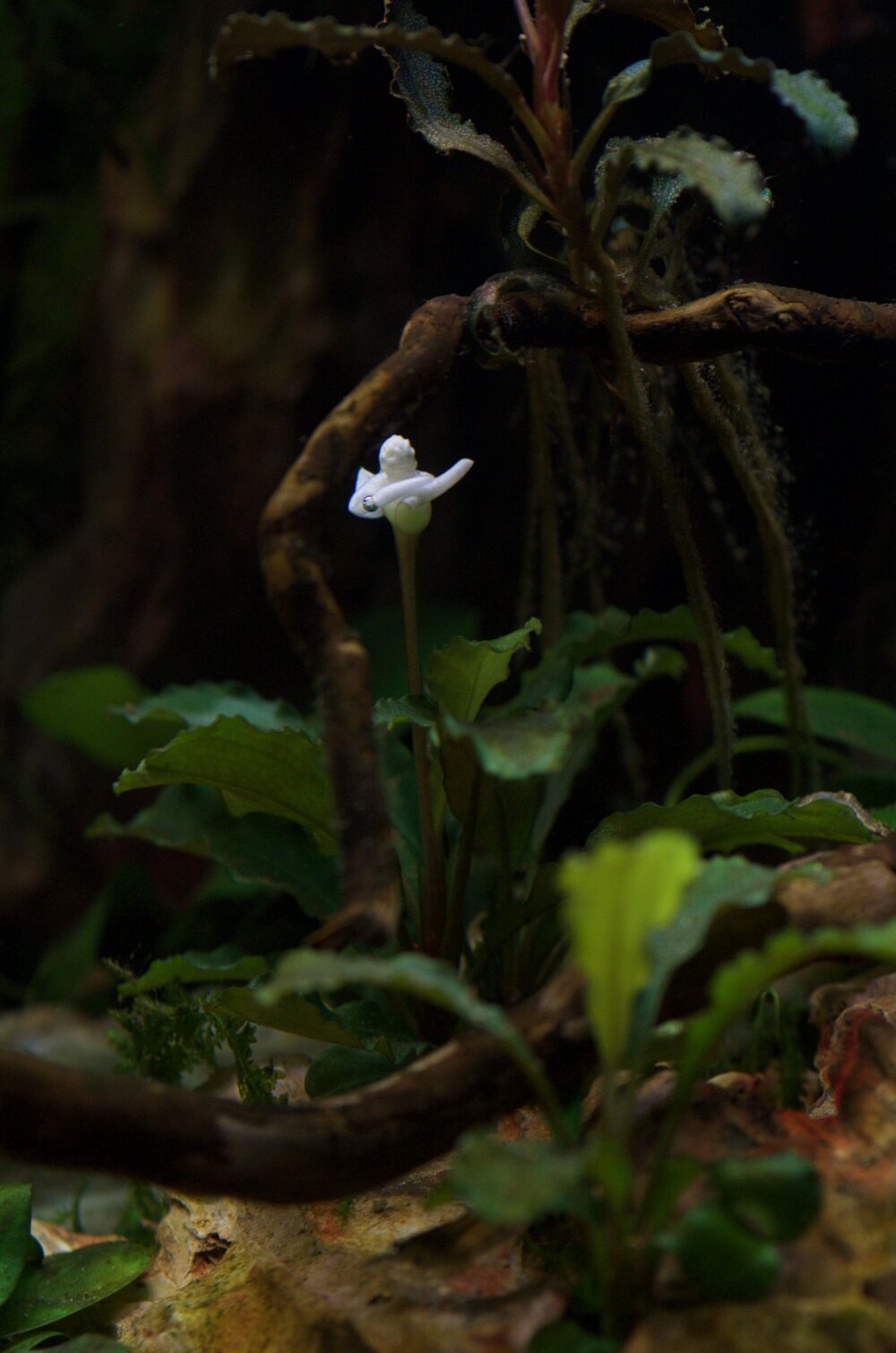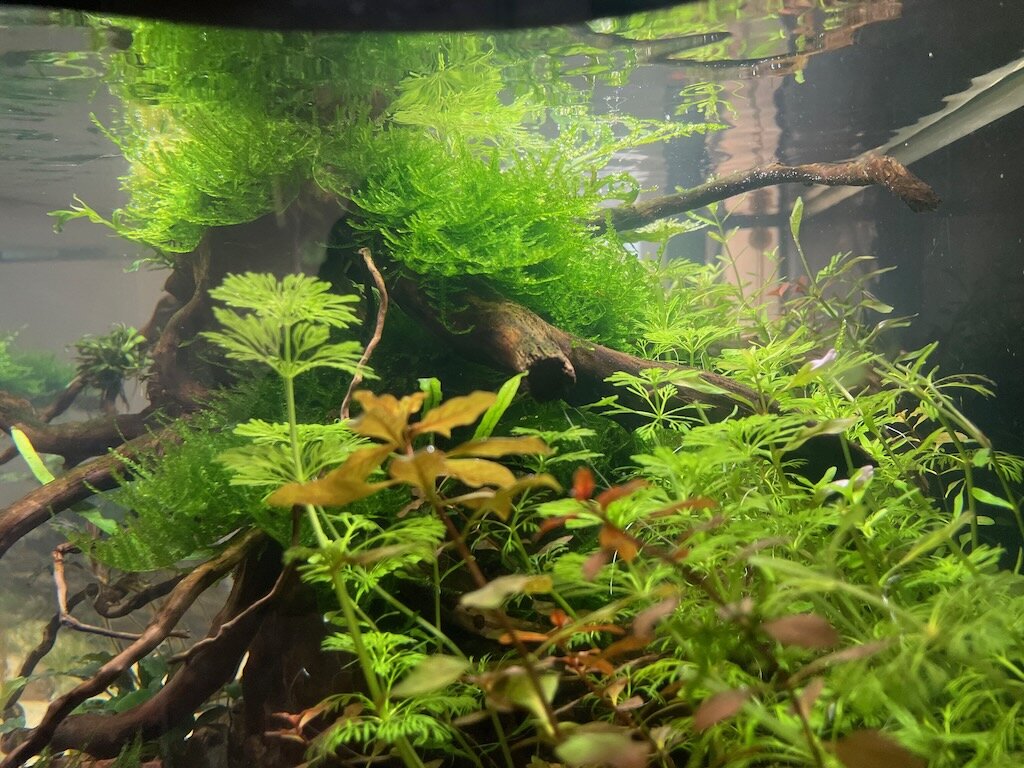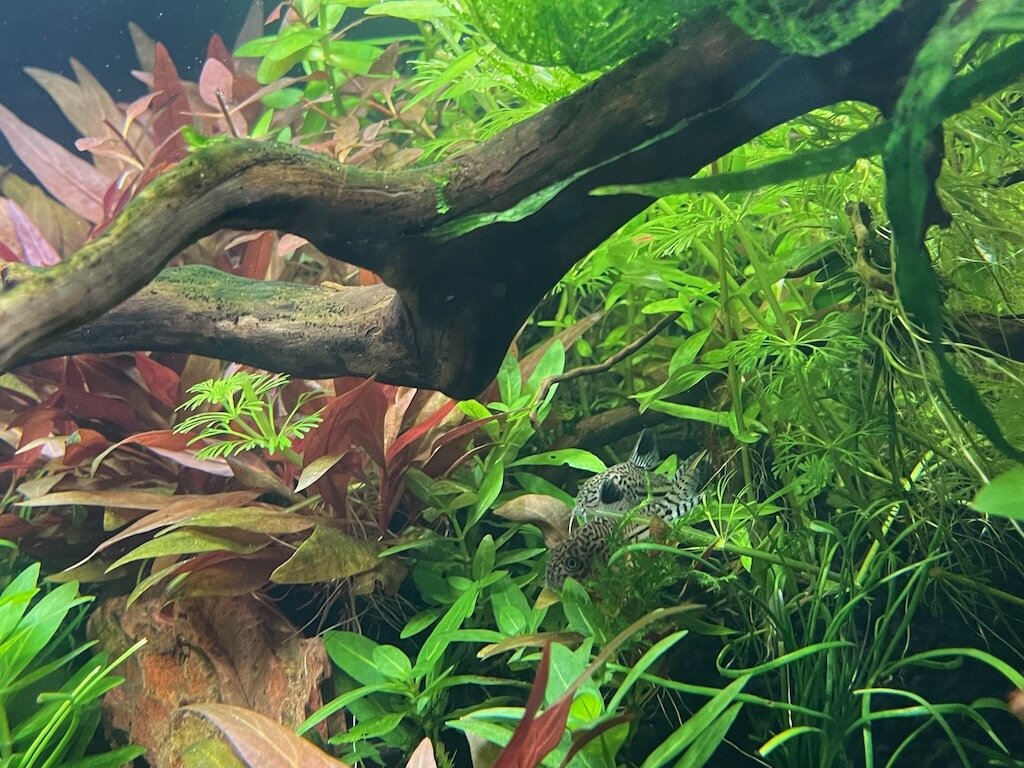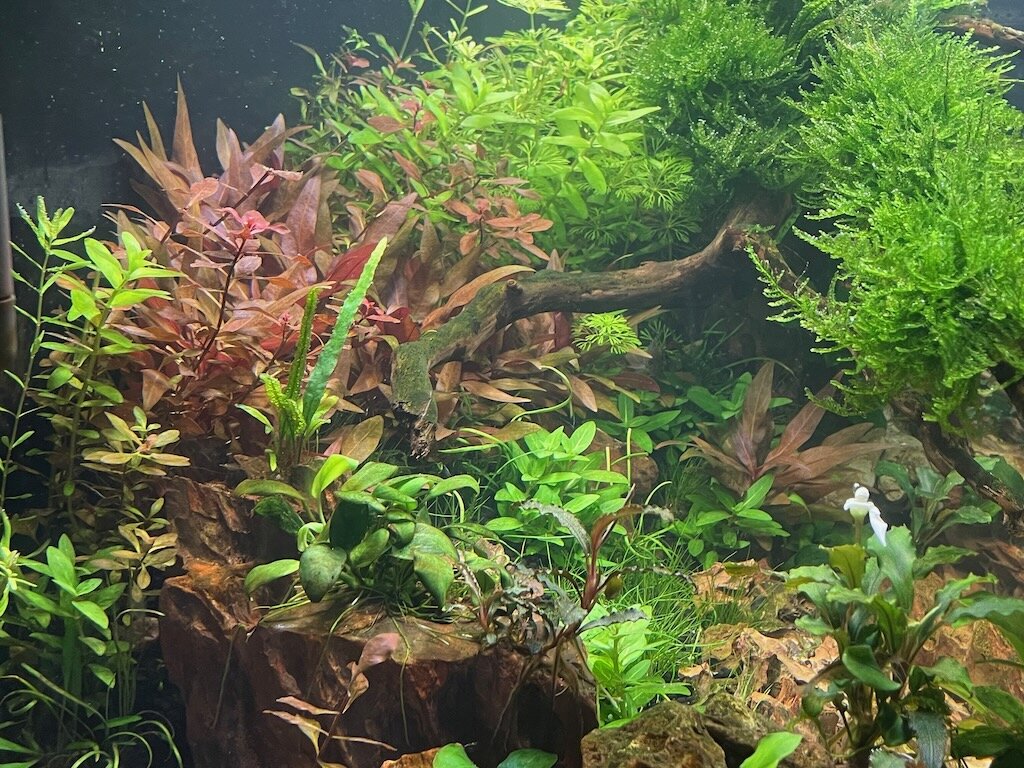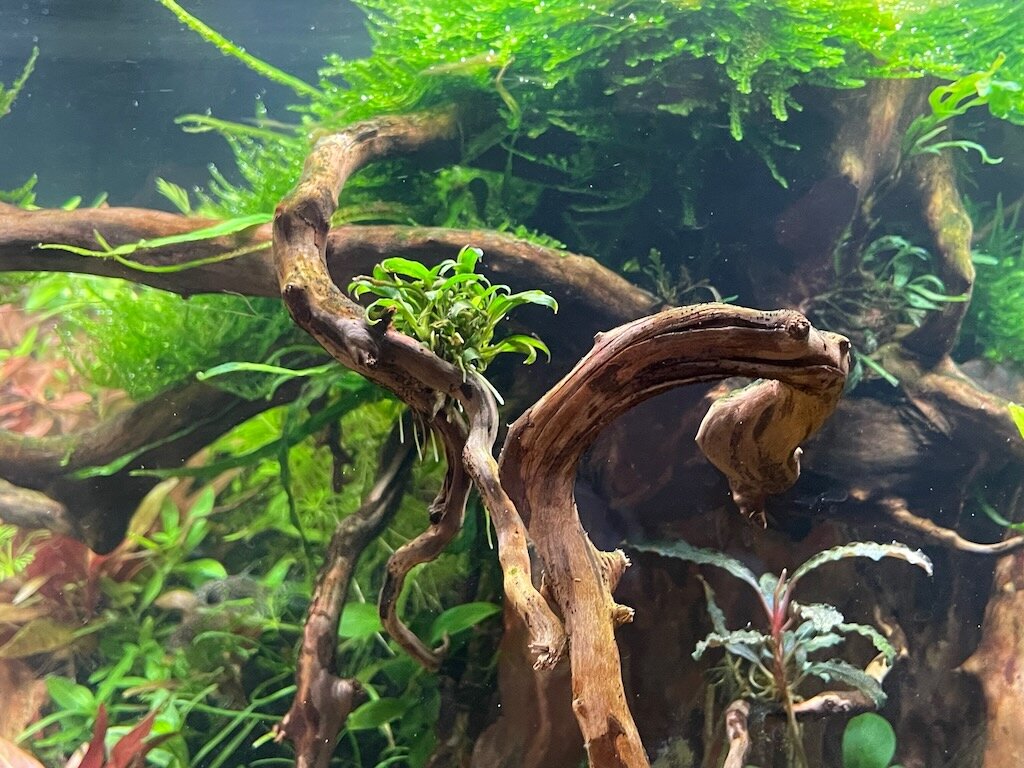Tonalscape
Member
I started posting this journal on two other sites and later decided to focus my time on ukaps. This is a full recap, rewrite, and up-to-the-minute report.
Let's start with constraints. I decided on a "40 Gallon Breeder", ie. 95x45x40cm, and got a stand with only a small storage cupboard and open space underneath, as this all looked well in the space (a living room with a piano at the front of our house). To greatly reduce the chance of flooding the hardwood, I chose an internal filter. I bought a load of dragon stone cheap, with no chance to pick bits that go together, and a lot of it had flat edges from the stone cutter. The price was worth the artistic constraint. I found a huge piece of red lava rock at a landscape yard and crushed it up and put it in mesh bags for the bottom substrate. And I shopped around and found a piece of spiderwood that I thought would work in the roots-side-down position.

I added Tropica soil and some leftover ADA Amazonia on top, and some inert sand. I ran the filter for a couple weeks, adding Seachem Stability for the first week. The tank was cycled. I planted on August 29th, and everything was tissue cultures, plus some potted stems and bucephelandra and bolbitis heudelotii. I started with about 15ppm CO2 and 2 mL of Tropica Specialized per day. This is Aug 31: notice the Sicce Pro 700 filter on the right glass, held on by magnet. The lights are Nicrew SkyLED Plus.

Below is Sept 13. I had just added more bolbitis at the front of the top of the wood, and moved narrow-leaved java fern around the back and left side of it. Limnophila Sessiflora and Ludwigia Palustris were standout stem growers. Eleocharis Acicularis in the "meadow" looked ok even though the roots were all rotten in the tissue cup. I increased CO2 gradually each week. By now my pH is around 7.4-7.6 un-gassed. kH 3, GH 7. pH 6.6-6.8 by the early part of lights-on. Other plants I'll mention now: anubias barteria nana and glabra and buce wavy green and kedagang on the rocks at the front of the tank.

The lighting period has been kept below 6 hr. The back light is on a higher setting than the front. They are both set about 20% brighter in the middle of the photo period. Below is a closeup from Sept 24, showing that the added bolbitis heudelotii, which came with a lot of blackened leaves, has only gotten worse (other bolbitis heudelotii from the first planting was fine and continues fine till this day). Eventually I had to trim all of the leaves right off.
Here you can also see that I've added weeping moss on the branch. I used cotton thread to tie it on. Also added anubias dragon minima (TC) on another branch.

Below we have Sept 29. Notice the nice red alternanthera reineckii mini and staurogyne repens (red and green "shrubs" on the edge of the "meadow"). Speaking of the meadow, the DHG has been damaged because I added too much ammonia trying to boost the bacteria population to get ready for adding shrimp. Had one day of about 4ppm ammonia before it all turned into nitrates. The S. Repens got holes in it, probably from the same thing. I'm sure the bolbitis heudelotii situation wasn't helped. Oops! btw you'll see I added an Oase Crystalskim on the upper back left.

Below I think I see on Oct 2 some iron deficiency - green-veined pale almost yellowish leaves on anubias/buce, and yellow tips on Lillaeopsis Mauritiana. The more brightly lit anubias and buce were the ones showing it. I got some help on APC forum. Tropica Specialized was already at 3mL/day. I added to that Tropica Premium 1 mL/day, and 1/64 tsp of 11% DTPA chelated iron. The first week I added one dry 1/64 tsp at water change (I've done 30-40% water changes weekly). Starting the second week I split that into daily liquid doses.

Oct 5, view from the side. Rotala Mexicana Bangladesh is grown well.
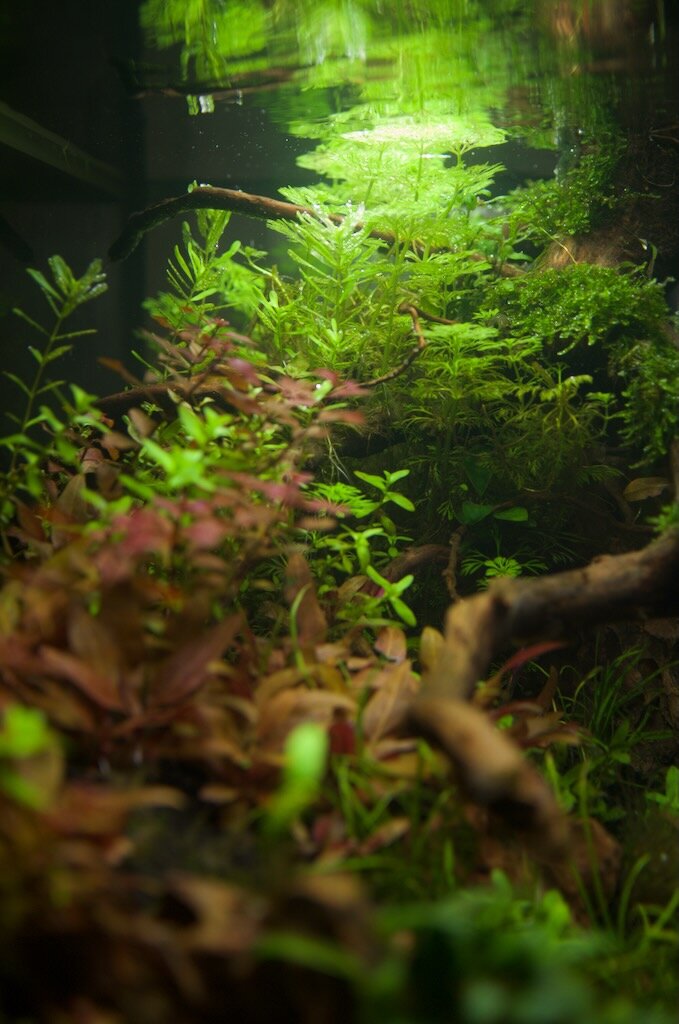
Oct 22nd, a bunch of brown cloudy algae at the back, right behind the upper wood and blocked from flow by the thick Limnophila Sessiflora.

Also Oct 22, the iron deficiency symptoms seem to have subsided.

Oct 31: a Halloween Ghost!

Also Oct 31:
DHG has grown back from just a few shoots to an encouraging level. Even the bolbitis heudelotii on the front, that I completely cut off, has a few shoots. A second week showed the same trouble spot for algae at the back, but less, with some attention to trimming the limnophila. Definitely diatoms came around and they seem to be hard to get off of some of the brightly lit anubias and buce. Have had a whole bunch of juvenile amanos, both white and regular, patrolling the grounds, for the last few weeks. Will add a photo of some of those to close it off.




Here ends the first chapter. Soon... fish! Any requests for more details, or tips, critiques, etc are very welcome.
Let's start with constraints. I decided on a "40 Gallon Breeder", ie. 95x45x40cm, and got a stand with only a small storage cupboard and open space underneath, as this all looked well in the space (a living room with a piano at the front of our house). To greatly reduce the chance of flooding the hardwood, I chose an internal filter. I bought a load of dragon stone cheap, with no chance to pick bits that go together, and a lot of it had flat edges from the stone cutter. The price was worth the artistic constraint. I found a huge piece of red lava rock at a landscape yard and crushed it up and put it in mesh bags for the bottom substrate. And I shopped around and found a piece of spiderwood that I thought would work in the roots-side-down position.

I added Tropica soil and some leftover ADA Amazonia on top, and some inert sand. I ran the filter for a couple weeks, adding Seachem Stability for the first week. The tank was cycled. I planted on August 29th, and everything was tissue cultures, plus some potted stems and bucephelandra and bolbitis heudelotii. I started with about 15ppm CO2 and 2 mL of Tropica Specialized per day. This is Aug 31: notice the Sicce Pro 700 filter on the right glass, held on by magnet. The lights are Nicrew SkyLED Plus.

Below is Sept 13. I had just added more bolbitis at the front of the top of the wood, and moved narrow-leaved java fern around the back and left side of it. Limnophila Sessiflora and Ludwigia Palustris were standout stem growers. Eleocharis Acicularis in the "meadow" looked ok even though the roots were all rotten in the tissue cup. I increased CO2 gradually each week. By now my pH is around 7.4-7.6 un-gassed. kH 3, GH 7. pH 6.6-6.8 by the early part of lights-on. Other plants I'll mention now: anubias barteria nana and glabra and buce wavy green and kedagang on the rocks at the front of the tank.

The lighting period has been kept below 6 hr. The back light is on a higher setting than the front. They are both set about 20% brighter in the middle of the photo period. Below is a closeup from Sept 24, showing that the added bolbitis heudelotii, which came with a lot of blackened leaves, has only gotten worse (other bolbitis heudelotii from the first planting was fine and continues fine till this day). Eventually I had to trim all of the leaves right off.
Here you can also see that I've added weeping moss on the branch. I used cotton thread to tie it on. Also added anubias dragon minima (TC) on another branch.

Below we have Sept 29. Notice the nice red alternanthera reineckii mini and staurogyne repens (red and green "shrubs" on the edge of the "meadow"). Speaking of the meadow, the DHG has been damaged because I added too much ammonia trying to boost the bacteria population to get ready for adding shrimp. Had one day of about 4ppm ammonia before it all turned into nitrates. The S. Repens got holes in it, probably from the same thing. I'm sure the bolbitis heudelotii situation wasn't helped. Oops! btw you'll see I added an Oase Crystalskim on the upper back left.

Below I think I see on Oct 2 some iron deficiency - green-veined pale almost yellowish leaves on anubias/buce, and yellow tips on Lillaeopsis Mauritiana. The more brightly lit anubias and buce were the ones showing it. I got some help on APC forum. Tropica Specialized was already at 3mL/day. I added to that Tropica Premium 1 mL/day, and 1/64 tsp of 11% DTPA chelated iron. The first week I added one dry 1/64 tsp at water change (I've done 30-40% water changes weekly). Starting the second week I split that into daily liquid doses.

Oct 5, view from the side. Rotala Mexicana Bangladesh is grown well.

Oct 22nd, a bunch of brown cloudy algae at the back, right behind the upper wood and blocked from flow by the thick Limnophila Sessiflora.

Also Oct 22, the iron deficiency symptoms seem to have subsided.

Oct 31: a Halloween Ghost!

Also Oct 31:
DHG has grown back from just a few shoots to an encouraging level. Even the bolbitis heudelotii on the front, that I completely cut off, has a few shoots. A second week showed the same trouble spot for algae at the back, but less, with some attention to trimming the limnophila. Definitely diatoms came around and they seem to be hard to get off of some of the brightly lit anubias and buce. Have had a whole bunch of juvenile amanos, both white and regular, patrolling the grounds, for the last few weeks. Will add a photo of some of those to close it off.




Here ends the first chapter. Soon... fish! Any requests for more details, or tips, critiques, etc are very welcome.


